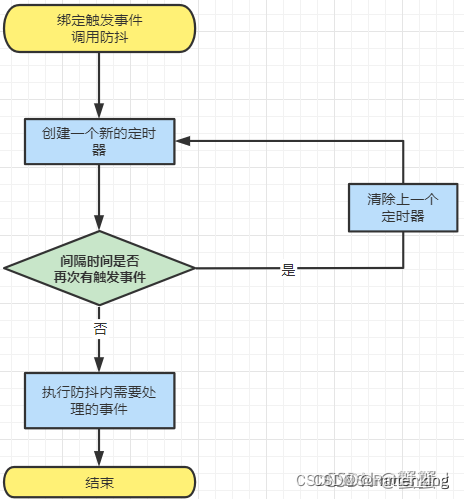防抖策略(java)
业务防抖(多次触发 只执行最后一次):
当事件被触发后,延迟n秒再执行回调,如果n秒内,事件又被触发,则重新计时。
作用
高频率触发的事件,在指定时间内,只响应最后一次,如果在指定时间内再次触发,则重新计算时间。
应用场景
- 登陆、发短信等避免用户点击太快 导致请求过多
- 在客户端网络慢或者服务器响应慢时,用户有时是会频繁刷新页面或重复提交表单的,这样是会给服务器造成不小的负担的,同时在添加数据时有可能造成不必要的麻烦。
流程图

java代码
使用切面+缓存的方式实现
<!-- redis redisson 配置 -->
<dependency>
<groupId>org.redisson</groupId>
<artifactId>redisson-spring-boot-starter</artifactId>
<version>${redisson.version}</version>
</dependency>
/**
* spring redis 工具类
*
* @author zhangyu
**/
@SuppressWarnings(value = {"unchecked", "rawtypes"})
@Component
public class RedisService {
@Autowired
public RedisTemplate redisTemplate;
@Resource
private Redisson redisson;
/**
* 缓存基本的对象,Integer、String、实体类等
*
* @param key 缓存的键值
* @param value 缓存的值
*/
public <T> void setCacheObject(final String key, final T value) {
redisTemplate.opsForValue().set(key, value);
}
/**
* 缓存基本的对象,Integer、String、实体类等
*
* @param key 缓存的键值
* @param value 缓存的值
* @param timeout 时间
* @param timeUnit 时间颗粒度
*/
public <T> void setCacheObject(final String key, final T value, final Long timeout, final TimeUnit timeUnit) {
redisTemplate.opsForValue().set(key, value, timeout, timeUnit);
}
/**
* 设置有效时间
*
* @param key Redis键
* @param timeout 超时时间
* @return true=设置成功;false=设置失败
*/
public boolean expire(final String key, final long timeout) {
return expire(key, timeout, TimeUnit.SECONDS);
}
/**
* 设置有效时间
*
* @param key Redis键
* @param timeout 超时时间
* @param unit 时间单位
* @return true=设置成功;false=设置失败
*/
public boolean expire(final String key, final long timeout, final TimeUnit unit) {
return redisTemplate.expire(key, timeout, unit);
}
/**
* 获取有效时间
*
* @param key Redis键
* @return 有效时间
*/
public long getExpire(final String key) {
return redisTemplate.getExpire(key);
}
/**
* 判断 key是否存在
*
* @param key 键
* @return true 存在 false不存在
*/
public Boolean hasKey(String key) {
return redisTemplate.hasKey(key);
}
/**
* 获得缓存的基本对象。
*
* @param key 缓存键值
* @return 缓存键值对应的数据
*/
public <T> T getCacheObject(final String key) {
ValueOperations<String, T> operation = redisTemplate.opsForValue();
return operation.get(key);
}
/**
* 删除单个对象
*
* @param key
*/
public boolean deleteObject(final String key) {
return redisTemplate.delete(key);
}
/**
* 删除集合对象
*
* @param collection 多个对象
* @return
*/
public long deleteObject(final Collection collection) {
return redisTemplate.delete(collection);
}
/**
* 缓存List数据
*
* @param key 缓存的键值
* @param dataList 待缓存的List数据
* @return 缓存的对象
*/
public <T> long setCacheList(final String key, final List<T> dataList) {
Long count = redisTemplate.opsForList().rightPushAll(key, dataList);
return count == null ? 0 : count;
}
/**
* 获得缓存的list对象
*
* @param key 缓存的键值
* @return 缓存键值对应的数据
*/
public <T> List<T> getCacheList(final String key) {
return redisTemplate.opsForList().range(key, 0, -1);
}
public <T> long leftPush(final String key, final T value) {
Long count = redisTemplate.opsForList().leftPush(key, value);
return count == null ? 0 : count;
}
public <T> T rightPop(final String key) {
ListOperations<String, T> operation = redisTemplate.opsForList();
return operation.rightPop(key);
}
/**
* 缓存Set
*
* @param key 缓存键值
* @param dataSet 缓存的数据
* @return 缓存数据的对象
*/
public <T> BoundSetOperations<String, T> setCacheSet(final String key, final Set<T> dataSet) {
BoundSetOperations<String, T> setOperation = redisTemplate.boundSetOps(key);
Iterator<T> it = dataSet.iterator();
while (it.hasNext()) {
setOperation.add(it.next());
}
return setOperation;
}
/**
* 获得缓存的set
*
* @param key
* @return
*/
public <T> Set<T> getCacheSet(final String key) {
return redisTemplate.opsForSet().members(key);
}
public Long removeCacheSet(String key, Object... values) {
return redisTemplate.opsForZSet().remove(key, values);
}
/**
* 缓存Map
*
* @param key
* @param dataMap
*/
public <T> void setCacheMap(final String key, final Map<String, T> dataMap) {
if (dataMap != null) {
redisTemplate.opsForHash().putAll(key, dataMap);
}
}
/**
* 获得缓存的Map
*
* @param key
* @return
*/
public <T> Map<String, T> getCacheMap(final String key) {
return redisTemplate.opsForHash().entries(key);
}
/**
* 往Hash中存入数据
*
* @param key Redis键
* @param hKey Hash键
* @param value 值
*/
public <T> void setCacheMapValue(final String key, final String hKey, final T value) {
redisTemplate.opsForHash().put(key, hKey, value);
}
/**
* 获取Hash中的数据
*
* @param key Redis键
* @param hKey Hash键
* @return Hash中的对象
*/
public <T> T getCacheMapValue(final String key, final String hKey) {
HashOperations<String, String, T> opsForHash = redisTemplate.opsForHash();
return opsForHash.get(key, hKey);
}
public <T> Long deleteCacheMapValue(String key, String... hKeys) {
HashOperations<String, String, T> opsForHash = redisTemplate.opsForHash();
return opsForHash.delete(key, hKeys);
}
public <T> Boolean hasCacheMapKey(String key, String hKey) {
HashOperations<String, String, T> opsForHash = redisTemplate.opsForHash();
return opsForHash.hasKey(key, hKey);
}
/**
* 获取多个Hash中的数据
*
* @param key Redis键
* @param hKeys Hash键集合
* @return Hash对象集合
*/
public <T> List<T> getMultiCacheMapValue(final String key, final Collection<Object> hKeys) {
return redisTemplate.opsForHash().multiGet(key, hKeys);
}
/**
* 获得缓存的基本对象列表
*
* @param pattern 字符串前缀
* @return 对象列表
*/
public Collection<String> keys(final String pattern) {
return redisTemplate.keys(pattern);
}
/**
* 获取自增版本
*/
public Long incrVersion(String key, long liveTime) {
RedisAtomicLong entityIdCounter = new RedisAtomicLong(key, Objects.requireNonNull(redisTemplate.getConnectionFactory()));
long increment = entityIdCounter.getAndIncrement();
if (increment == 0 && liveTime > 0) {
entityIdCounter.expire(liveTime, TimeUnit.DAYS);
}
return increment;
}
/**
* 获取自增id
*/
public Long getAutoId(String prefix) {
String key = prefix + ":auto-id";
RedisAtomicLong entityIdCounter = new RedisAtomicLong(key, Objects.requireNonNull(redisTemplate.getConnectionFactory()));
long increment = entityIdCounter.getAndIncrement();
if (increment == 0) {
return entityIdCounter.getAndIncrement();
} else {
return increment;
}
}
public void zAdd(String key, Object value, double score) {
redisTemplate.opsForZSet().add(key, value, score);
}
public Set<Object> rangeByScore(String key, double min, double max, long offset, long count) {
return redisTemplate.opsForZSet().rangeByScore(key, min, max, offset, count);
}
public Long zCard(String key) {
return redisTemplate.opsForZSet().zCard(key);
}
public void setIncrement(String key, int i) {
redisTemplate.opsForValue().increment(key, i);
}
/**
* 尝试获取分布式锁
*/
public RLock getLock(String lockKey) {
return redisson.getLock(lockKey);
}
/**
* 释放分布式锁
*
* @param lockKey 锁
* @param requestId 请求标识
* @return 是否释放成功
*/
public void unLock(String lockKey, String requestId) {
RLock lock = redisson.getLock(lockKey);
lock.unlock();
}
}
@Documented // 生成接口文档
@Target({ElementType.METHOD}) // 作用到方法上
@Retention(RetentionPolicy.RUNTIME) // 运行时有效
public @interface NoRepeatSubmit {
/**
* 名称 如果没有就是默认的
* @return
*/
String name() default "name";
}
/**
* @author zrx
*/
@Aspect
@Slf4j
@Component
public class NoRepeatSubmitAspect {
@Resource
private RedisService redisService;
@Pointcut("@annotation(com.ai.platform.cloud.common.core.annotation.NoRepeatSubmit)")
public void pt() {
}
@Before(value = "pt()")
public void doBefore() {
}
@Around(value = "pt()")
public void doAround(ProceedingJoinPoint joinPoint) throws Throwable{
ServletRequestAttributes servletRequestAttributes = (ServletRequestAttributes) RequestContextHolder.getRequestAttributes();
assert servletRequestAttributes != null;
HttpServletRequest request = servletRequestAttributes.getRequest();
Map<String, String[]> parameterMap = request.getParameterMap();
// 这里是唯一标识
String redisKey = "NO_REPEAT_SUBMIT_TEST:" + parameterMap.get("key")[0];
// 如果缓存中有这个url视为重复提交
if (!redisService.hasKey(redisKey)) {
joinPoint.proceed();
redisService.setCacheObject(redisKey, 0, 15L, TimeUnit.SECONDS);
} else {
log.info("请勿重复提交或操作过于频繁!");
throw new BizException("请勿重复提交或操作过于频繁");
}
}
@After(value = "pt()")
public void doAfter() {
}
}
@ApiOperation(value = "防抖测试")
@GetMapping("/repeat/submit")
@NoRepeatSubmit(name = "test")
public R replayGet(@RequestParam String key) {
log.info("防抖测试。。。");
return R.ok();
}
参考链接:
https://blog.csdn.net/m0_38082783/article/details/127749408